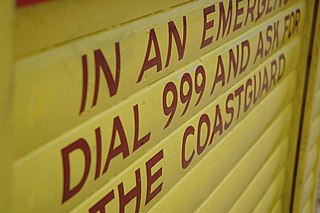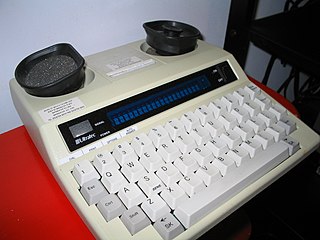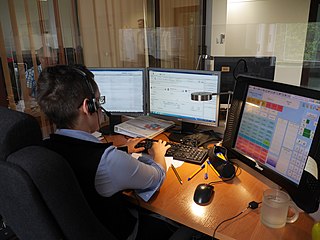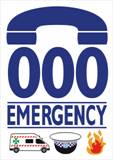Enhanced 911 is a system used in North America to automatically provide the caller's location to 911 dispatchers. 911 is the universal emergency telephone number in the region. In the European Union, a similar system exists known as E112 and known as eCall when called by a vehicle.

An emergency telephone number is a number that allows a caller to contact local emergency services for assistance. The emergency number differs from country to country; it is typically a three-digit number so that it can be easily remembered and dialed quickly. Some countries have a different emergency number for each of the different emergency services; these often differ only by the last digit.

999 is an official emergency telephone number in a number of countries which allows the caller to contact emergency services for emergency assistance. Countries and territories using the number include Bahrain, Bangladesh, Botswana, Eswatini, Ghana, Guernsey, Hong Kong, Ireland, Isle of Man, Jersey, Kenya, Macau, Malaysia, Mauritius, Poland, Qatar, Sudan, Saudi Arabia, Singapore, Trinidad and Tobago, Seychelles, Uganda, the United Arab Emirates, the United Kingdom, and Zimbabwe.

The North American Numbering Plan (NANP) is a telephone numbering plan for twenty-five regions in twenty countries, primarily in North America and the Caribbean. This group is historically known as World Zone 1 and has the telephone country code 1. Some North American countries, most notably Mexico, do not participate in the NANP.

A telecommunications device for the deaf (TDD) is a teleprinter, an electronic device for text communication over a telephone line, that is designed for use by persons with hearing or speech difficulties. Other names for the device include teletypewriter (TTY), textphone, and minicom.
A toll-free telephone number or freephone number is a telephone number that is billed for all arriving calls. For the calling party, a call to a toll-free number from a landline is free of charge. A toll-free number is identified by a dialing prefix similar to an area code. The specific service access varies by country.

A telecommunications relay service, also known as TRS, relay service, or IP-relay, or Web-based relay service, is an operator service that allows people who are deaf, hard of hearing, deafblind, or have a speech disorder to place calls to standard telephone users via a keyboard or assistive device. Originally, relay services were designed to be connected through a TDD, teletypewriter (TTY) or other assistive telephone device. Services gradually have expanded to include almost any real-time text capable technology such as a personal computer, laptop, mobile phone, PDA, and many other devices. The first TTY was invented by deaf scientist Robert Weitbrecht in 1964. The first relay service was established in 1974 by Converse Communications of Connecticut.
111 is the emergency telephone number in New Zealand. It was first implemented in Masterton and Carterton on 29 September 1958, and was progressively rolled out nationwide with the last exchanges converting in 1988.

The Australian telephone numbering plan governs the allocation of telephone numbers in Australia. It has changed many times, the most recent major reorganisation by the Australian Communications and Media Authority taking place between 1994 and 1998.

A public-safety answering point (PSAP), sometimes called public-safety access point, is a call center where emergency/non-emergency calls initiated by any landline, mobile or Voice Over Internet Protocol ("VOIP") subscriber is terminated. It can also happen that when 112 is dialed in then a logic is implemented by mobile or network operators to route the call to the nearest police station. It is a call center in almost all the countries including Canada and the United States responsible for answering calls to an emergency telephone number for police, firefighting, and ambulance services. Trained telephone operators are also usually responsible for dispatching these emergency services. Most PSAPs are now capable of caller location for landline calls, and many can handle mobile phone locations as well, where the mobile phone company has a handset to location system. Some can also use voice broadcasting where outgoing voice mail can be sent to many phone numbers at once, in order to alert people to a local emergency such as a chemical spill.
A landline is a telephone connection that uses metal wires from the owner's premises sometimes referred to as: "Pots", Twisted pair, telephone line, public switched telephone network or Bell System for transmissions. As landline services are typically provided via a telephone company's central office and are hard-wired it is mainly distinguished from electronic communications to/from the premiss that provide similar phone services using either: optical fiber (Fiber-to-the-x) or internet, or computer-network connections : such as digital phone or Voice over IP; or mobile cellular network or Wi-Fi, which uses radio waves for transmission.

000 Emergency, also known as Triple Zero or Triple 0, and sometimes stylised Triple Zero (000), is the primary national emergency telephone number in Australia. The Emergency Call Service is operated by Telstra, and overseen by the Australian Communications and Media Authority (ACMA), and is intended only for use in life-threatening or time-critical emergencies.
119 (one-one-nine) is an emergency telephone number in parts of Asia and in Jamaica. From May 2020, 119 was introduced in the United Kingdom as the single non-emergency number for the COVID-19 testing helpline in England, Wales, and Northern Ireland. From January 2022, 119 was introduced in Romania as the single non-emergency number for reporting cases of abuse, neglect, exploitation and any other form of violence against the child.

The New Zealand telephone numbering plan describes the allocation of telephone numbers in New Zealand and the Pitcairn Islands.
Area code 710 is a special area code in the North American Numbering Plan (NANP). It was reserved for the federal government of the United States in 1983 for emergency services. Since 1994, the area code has provided access for authorized personnel to the Government Emergency Telecommunications Service (GETS) in the United States, and the Canadian local exchange carriers, and cellular/PCS networks. Previously, it was a Service Access Code (SAC) in the Teletypewriter Exchange Service (TWX) for the northeastern part of the United States.

A telephone number is a sequence of digits assigned to a landline telephone subscriber station connected to a telephone line or to a wireless electronic telephony device, such as a radio telephone or a mobile telephone, or to other devices for data transmission via the public switched telephone network (PSTN) or other public and private networks.

The Latvian telephone numbering plan is a telephone number assigning system used in Latvia. All the numbers consist of 8 digits with exceptions for special services. The assigning process is controlled by the Electronic Communications Office and regulated by the Public Utilities Commission.
Ringing is a telecommunication signal that causes a bell or other device to alert a telephone subscriber to an incoming telephone call. Historically, this entailed sending a high-voltage alternating current over the telephone line to a customer station which contained an electromagnetic bell. It is therefore also commonly referred to as power ringing, to distinguish it from another signal, audible ringing, or ringing tone, which is sent to the originating caller to indicate that the destination telephone is in fact ringing.
James Carlyle Marsters was a deaf orthodontist in Pasadena, California who in 1964 helped invent the first teletypewriter device capable of being used with telephone lines. The device made communication by telephone possible for the deaf. Although Robert Weitbrecht did much of the actual design work, Marsters promoted the device's use.











